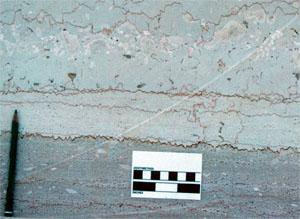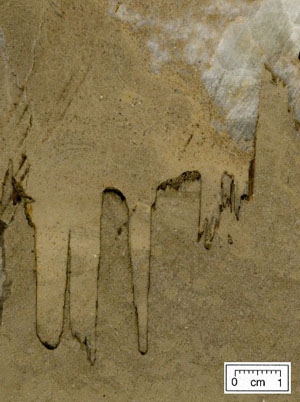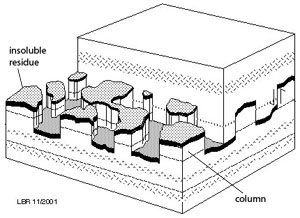| |||||||
|
|
|||||||
|
|
|||||||
| Stylolites | |||||||
|
Stylolite refers to pressure solution seams with inter-penetrating suture-like structures. The geometry of the column or teeth may be square, conical, circular, or sinusoidal (Figure 1 and Figure 2). The term is commonly used to refer to bed-parallel pressure solution seams (Tada and Seiver, 1989). This usage is retained here just to be faithful to the historical context of the use of the term but we simply use the general term 'bed-parallel pressure solution seam' when we describe pressure solution seams with various geometries and discuss their formation mechanisms. The caps of the columns contain thick seams such as those illustrated in Figures 1 and 2, while the sides of the columns contain much less or no seams and were commonly slickensided. Thus, a 3-D geometry of a well-develop stylolite (Figure 3) contains islands of seams (caps) separated by sheared shoulders (sides) with little or no residue. Stockdale (1922) was one of the early geologists who analyzed and documented the compositional and geometric properties of stylolites in limestone. He showed that the darker seams of the columns had the same mineralogical composition, oxide ratios, and organic matter percentage as the insoluble residue component of the equivalent adjacent rock matrix. Thus the kinematics of the stylolites involves pressure solution across the caps and slip parallel to the column axis across the sides. Stylolite seams are rarely planar. They often curve, twist, and turn making large angles to the average orientation of their seams, especially to follow some compositional heterogeneity of the rock, but the columns remain pretty much parallel to each other with column axis in the direction of shortening. There are two important geometric parameters of individual stylolites: the thickness of the seams and the roughness and amplitude of the columns. Stockdale (1922) proposed that the height of the columns and the thickness of the residue are proportional to the amount of the dissolved material. Please see the sections on 'Pressure Solution Seam Thickness Distribution' and 'Pressure Solution Seams Roughness (Amplitude of Stylolites)' for more discussion. | |||||||
| Reference: |
|||||||
| Stockdale, P.B., 1922 Tada, R., Siever, R., 1989 |
|||||||
|
Readme | About Us | Acknowledgement | How to Cite | Terms of Use | Ⓒ Rock Fracture Knowledgebase |
|||||||


